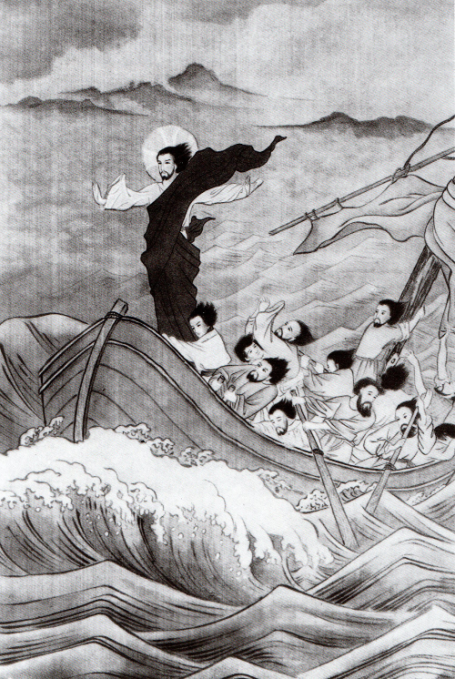
The painting ‘Stilling the Tempest’ is a powerful visual exegesis of Mark 4.39 and Jesus’ command, “Peace! Be still!” I first came across it in the wonderful volume by Jaroslav Pelikan, Jesus Through the Centuries, a book I used as a text book teaching a module with the same title. This was one of the images a number of students found moving, and it always provoked discussion.
Jesus with a Chinese face, is standing in the place of command at the prow of the boat. Mountainous seas with real mountains on the horizon, the whole scene a cauldron of threat and danger. The desperation of the oarsmen, the loss of control signalled by their lost rhythm, the faces set in expressions of fear or determined resignation, all conveyed with power. In the foreground a massive billow, reminiscent of a tsunami and originating under the boat, heads towards the viewer of the painting.
But the dominating figure of Jesus stands with arms outstretched and hands raised, upright and balanced in a boat tossed by elemental powers doing their utmost to overwhelm. Of course he stands in a cruciform gesture, redemptive and powerful at the same time. His authority over the waves and the wind is emphasised by the disciple clinging to his legs, while another has his arms raised imploring Jesus, and yet another clings to the mast but strains round to fix his eyes on Jesus.
It is an astonishing achievement which captures the full force of the storm just before Jesus speaks. The sea is in full tempest mode, the boat is riding a tsunami, the land is miles behind them, and left on their own, experienced sailors as they are, they are doomed. Except for that dominant cruciform Jesus, about to command stillness.
Yet Mark says clearly that Jesus was at the back, in the stern of the boat, asleep. In the picture Jesus is shown to be high and lifted up, at the front. This is of course artistic licence, but making its own theological point; the artist’s interpretation is supported by the verb Mark uses which is an intensified form of rising, describing Jesus’ action as standing up to his full height. And the place of authority and the highest point is the uplifted prow
Perhaps the reason the picture is called ‘Stilling the Tempest’, a title which uses the present participle, is precisely to convey the urgent authority of Jesus, striding from stern to prow. The picture then becomes a portrait of that moment just as Jesus is about to speak two commands; to the wind, “be quiet!, and to the sea, “be calm!”
The Chinese artist, Monika Liu Ho-Peh, has captured that dramatic split second, when with oars all over the place, sails ripped, bodies exhausted, impending doom is forestalled and frustrated by impending deliverance. And that is exactly how Mark portrays Jesus.
Leave a Reply